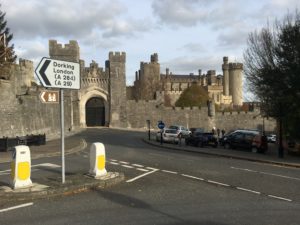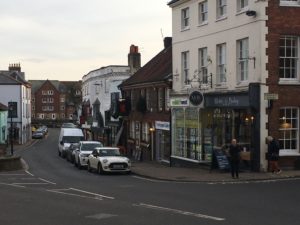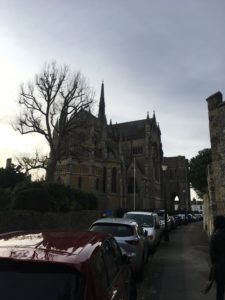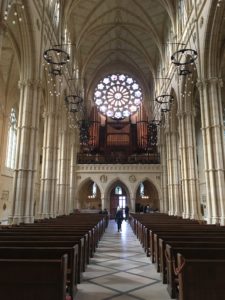“Ah yes, but by which route? The direct route or the scenic route?” Sylvester McCoy as the Doctor

Today we elected to drive all the way from Lytchett Matravers to Hastings, a route that would take us mainly along the southern coast (but not near enough to see it) on the M27 and then later the A27—a drive over 130 miles that probably ended up taking us well over 4 hours total on account of rush hour traffic through Brighton. If there’s one thing I’d change about this holiday so far, it would be to choose two places in the countryside and spend three nights in each place—Stratford and then Hastings, say. On account of the limited daylight hours in November and the distance of the areas of the country we were interested in seeing, this would actually end up maximizing the time we have to see what we wanted to see. At the moment, it feels like we’ve spent more time in the car driving in darkness than we have actually seeing things.

So, due to the distance to our next destination, we decided to break up the drive a bit by stopping in Arundel, a town near the coast (but not quite on the coast), located roughly halfway between Lytchett Matravers and Hastings. When the idea of visiting Arundel came up, I became even more excited because I knew that in 1988, the BBC had filmed great parts of a serial from Doctor Who there called Silver Nemesis—a serial that celebrated the programme’s 25th anniversary. So I suddenly found myself getting excited about seeing locations that they used, however insignificant the street corner or stone wall might have seemed.
Upon arriving, we first had a lovely breakfast (we’ve yet to have any hint of a disappointing meal here) at a quaint little restaurant called the Motte and Bailey (Amy and I opting for scrambled eggs and salmon, Shawn a burger, and Marie and Aaron an eggs royale of salmon and eggs on toast with hollandaise). The restaurant itself is named after a tower built on a mound (the motte) surrounded by a courtyard (the bailey) and suggested to us by a pleasant gentleman who we spoke to at the Arundel Museum who also helped us settle some questions we had about how to use our signals (or rather, indicators) as we navigate a roundabout (and who haltingly guessed we were from the U.S., our Minnesota accents possibly suggesting a Canadian origin).

Sadly, the real highlight of the town, the 900-year-old Arundel Castle that loomed imposingly on top of the hill over the rest of the town and which doubled as Windsor Castle in Silver Nemesis, was closed for the winter season. We were still able to take some magnificent pictures of the structure, but it’s quite a pity we weren’t able to explore inside. We were, however, able to explore two other structures, first the Parish and Priory Church of Saint Nicholas, a modest and small little church of grey stones built in 1318, complete with an organ from 1817 by William Grey and Son, it’s pipes colored in patterns of deep reds and sky blues, all set within an elegantly stained wooden case, standing several meters high. The floor was also exquisitely and carefully laid with tiles from the 19th century by Godwin of Herefordshire, the color of wine and slate, arranged in perfect squares situated at a 45 degree angle as to suggest square diamonds pointing the way towards the altar.
Down the same street just barely a five minute walk away is the less modest Arundel Cathedral of Our Lady and Saint Philip of Howard, built in the 19th century and opened in 1873. It is a French Gothic style building made of stones that I imagine were once gleaming white but have since succumbed to hues of pale yellows and light browns as age and stains made their marks with the passing decades. This structure, too, was complete with an organ (but a much larger organ), it’s pipes decorated in ornate patterns of reds and golds, magnificently towering over the space up in the loft rather than unassumingly to the left of the high altar as it was at Saint Nicholas. Also on display were examples of Victorian stained glass humbly lit by the shy November English sun; a limewood statue of Saint Philip Howard himself depicting him with his faithful dog and sole companion when he was imprisoned in the Tower of London; and all fourteen Stations of the Cross delicately inset into the walls.

Before we left Arundel, we managed to take a brief walk through Arundel Park, a lovely and large open green space with Hiorne Tower standing lonely in the distance. It was built in the 19th century, is apparently haunted (if you believe in such nonsense), but was most definitely used in Silver Nemesis as Lady Peinforte’s tomb. After a quick stop at a lovely tea shop called the Tea and Biscuit Club (a small space with barely enough room for 10 people but more than enough room for countless varieties of tea, tea pots, and infusers, where a young gentleman suggested I purchase their black tea blend called Castle Classic after I indicated my desire for a strong breakfast tea), we made our way to Hastings via Brighton where we barely had enough time as the car made its way through the city to take photos of the Royal Pavilion, an impressive structure of domes and minarets of the Indo-Saracenic style popular in India in the 19th century, brightly lit up at night in colors of red and blues.
And after much stopping and going through Brighton’s rush hour traffic, we at last arrived in Hastings where we enjoyed a lovely, lovely meal of meat pies and cheesy leeks at a pub called Albion, where, incidentally, they were also hosting a kind of 1950s dance night, a DJ spinning actual vinyl records as couples danced actual dances based on actual dance patterns of the day (or so I might assume).
Our journey in the countryside sadly will come to a close tomorrow as we finish our adventures in Hastings before returning to London for the rest of our stay (apart from an exciting day trip to Paris).
